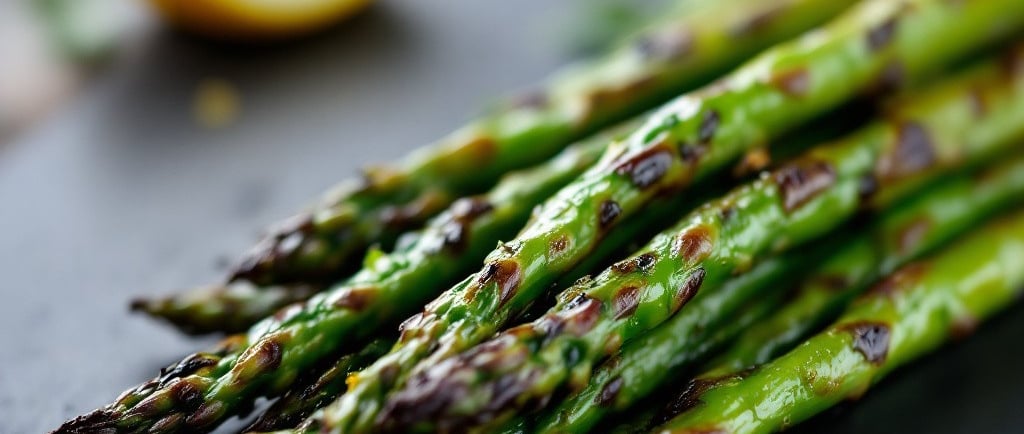Sautéed Asparagus with Garlic & Lemon
Sautéed asparagus is simple, delicious, and packed with flavor.
SIDE DISHVEGETARIAN
Lourdes Rodriguez
3/17/20254 min read


Origin and History of Asparagus:
Asparagus has been cultivated for thousands of years. It is believed to have originated in the eastern Mediterranean region, particularly in ancient Greece and Rome. The name asparagus comes from the Greek word aspharagos, which means “sprout” or “shoot.” It was prized by ancient civilizations for its delicate flavor and medicinal properties. Roman Emperor Augustus was so fond for asparagus that he even coined the phrase “faster than you can cook asparagus” likely referring to the speed at which he wanted things done. In the Middle Ages, asparagus was grown in monastery gardens, and it spread throughout Europe in the 16th century.
The Best Season to Enjoy Asparagus
Asparagus is typically in season during spring, from March to June in the Northern Hemisphere. The peak season is around April and May when it is freshest and most abundant. You will find it at its best during these months.
Health Benefits of Asparagus:
Asparagus is a nutrient-dense vegetable that offers numerous health benefits:
Rich in Nutrients: Asparagus is high in vitamins A, C, E, and K, as well as folate. It also contains a variety of minerals like potassium, iron, and copper.
Supports Digestive Health: It’s a good source of fiber, which helps promote healthy digestion and prevent constipation.
Promotes Heart Health: Asparagus is rich in antioxidants, including vitamin E and flavonoids, which help protect the heart by reducing oxidative stress.
Anti-inflammatory: The high level of antioxidants and nutrients in asparagus helps reduce inflammation in the body.
Good for Weight Loss: Asparagus is low in calories and high in water content, making it a great option for those looking to maintain or lose weight.
Tips to Prepare the Perfect Asparagus:
Peel the Stems: For thicker asparagus stalks, you can use a vegetable peeler to remove the tough skin on the lower part of the stalk.
Cut the Ends Properly: The woody end of asparagus is tough and unpleasant to eat, so make sure to snap off the tough bottom ends by bending them gently – they naturally break at the right point.
Do not Overcook: Asparagus cooks quickly. Whether blanching, steaming, or sautéing, be careful not to overcook it, as it will become mushy and lose its vibrant color.
Choose the Right Size: Thinner asparagus is more tender and may need less cooking time. Larger, thicker stalks are a bit tougher but more flavorful, and can be great for grilling or roasting.
How Not to Eat Asparagus:
Do not Eat Raw Asparagus: While some people enjoy raw asparagus in salads, it can be tough and fibrous, which might make it difficult to digest. Cooking is usually the best way to enjoy it.
Avoid Overcooking: If you overcook asparagus, it becomes mushy and loses most of its flavor and nutrients. Always aim for a crisp-tender texture.
Blanching Asparagus
Blanching asparagus is the perfect way to lock in its vibrant color, fresh flavor, and crisp-tender texture. It also speeds up cooking, ensuring even doneness when sautéed, grilled, or roasted. Here’s how to do it right:
Prepare an Ice Bath: Fill a large bowl with ice and water. This will immediately stop the cooking process after blanching, preserving the asparagus's texture and color.
Trim the Asparagus: Cut off the tough, woody ends, typically about 1–2 inches from the bottom.
Boil Water: Bring a large pot of water to a rolling boil. Add a pinch of salt (optional) to enhance the asparagus’s flavor and color.
Blanch: Drop the asparagus into the boiling water and cook according to these guidelines:
Thin spears: 1–2 minutes
Medium spears: 2–3 minutes
Thick spears: 3–4 minutes
Cool: Quickly transfer the asparagus to the ice bath to halt cooking. Let them sit for a few minutes, then drain and pat dry.
Sauté: Once dry, sauté the asparagus for 2–3 minutes until lightly caramelized and tender.
Sautéed Asparagus with Garlic & Lemon
Ingredients:
1 lb. asparagus (blanched or fresh)
2 tbsp olive oil or butter
2-3 cloves garlic (minced)
Zest of 1 lemon
Juice of 1/2 lemon
Salt and pepper to taste
Optional: Fresh herbs (like thyme or parsley)
Instructions:
Prepare the Asparagus: If you have not already, trim the asparagus ends and cut into 2-inch pieces for bite-sized portions.
Heat Oil: In a large skillet, heat olive oil or butter over medium heat.
Sauté Garlic: Add minced garlic and sauté for 30 seconds to a minute, until fragrant but not burnt.
Add Asparagus: Add the asparagus to the pan and cook for 5-7 minutes, stirring occasionally, until tender but still crisp.
Season: Add lemon zest, lemon juice, salt, and pepper. Toss to combine and cook for another minute to allow the flavors to blend.
Serve: Garnish with fresh herbs and serve immediately.
Main & Side Dishes Ideas to Pair with Sauteed Asparagus:
Main Dishes:
Grilled Chicken - The mild flavor of grilled chicken complements the savory richness of sauteed asparagus. Add a squeeze of lemon over both for a bright, fresh pairing.
Salmon or Other Fish - Asparagus and fish are a classic combo, especially with pan-seared salmon. The delicate fish flavors and the earthy, slightly sweet asparagus work harmoniously together.
Pasta - Sauteed asparagus can be added to a pasta with other fresh vegetables. The light, fresh flavors of the pasta dish highlight the natural sweetness of the asparagus.
Side Dishes:
Mashed Potatoes - The creamy, buttery texture of mashed potatoes complements the crispness of sauteed asparagus, creating a balanced and comforting dish.
Quinoa or Couscous Salad - A light, flavorful grain salad with herbs and lemon pairs beautifully with the earthy taste of asparagus, offering a fresh contrast.
Fun Fact: Why Does Asparagus Make Urine Smell Different?
Asparagus contains asparagusic acid, which breaks down into sulfur-containing compounds during digestion. These compounds are responsible for the distinct odor in urine, which can appear as soon as 15–30 minutes after eating asparagus! Interestingly, not everyone can detect the smell due to genetic differences in smell perception.
Some Individuals May Need to Limit or Avoid Asparagus Due to Specific Health Conditions:
People with Kidney Stones - Asparagus is high in purines, which break down into uric acid in the body. Excess uric acid can contribute to kidney stone formation, especially in people prone to uric acid or calcium oxalate stones.
Those with Gout - Since asparagus increases uric acid levels, it can trigger or worsen gout attacks in susceptible individuals.
People on Blood Thinners (Like Warfarin) - Asparagus is rich in vitamin K, which plays a key role in blood clotting. People taking blood thinners should consume vitamin K-rich foods in moderation to avoid interfering with their medication.
Individuals with Asparagus Allergy- Though rare, some people may experience allergic reactions, including skin rashes, itching, swelling, or difficulty breathing after eating asparagus.
Those with Digestive Sensitivities - Asparagus contains inulin, a type of fiber that can cause bloating, gas, or digestive discomfort, especially in people with IBS (Irritable Bowel Syndrome) or sensitive stomachs.
Important: If you have any questions about incorporating this food into your diet, it's always a good idea to consult your dietitian or doctor.
Plenitaste
Inspiring healthy, global recipes for everyone.
contact me:
Recipe
plenitaste@gmail.com
© 2025. All rights reserved.
